

By
Don and Linda Freedman
Search
TheTravelzine
TheTravelzine Group
Access Your Mail
Don's
Gallery
Packing
Hints
Planning
Tips
Cities
Links
Links
LINKS TO OUR TRAVELOGUES
Argentina, Buenos Aires - Jan-Mar 2010
Argentina, Buenos Aires - Jan-Mar 2009
Argentina, Buenos Aires - Jan-Mar 2008
Austria - Fall 2005
Belgium, Brussels - Fall 2000
Canada - Summer 2002
Canada - Summer 2001
Canada - Summer 2000
Czech Republic - Spring 2000
France - Fall 2002
France, Paris - Fall 2000
France, Paris - Spring 1999
France, Lyon - Spring 1999
Germany, Berlin - Fall 2009
Germany - Fall 2002
Germany - Spring 2000
Germany - Fall 1999
Greece - Fall 2012
Greece - Fall 1999
Greece - Fall 1997
Hungary - Spring 2000
Israel - Fall 1999
Italy - Winter 2007
Italy - Winter 2006
Italy - Winter 2005
Italy - Winter 2004
Italy - Winter 2003
Italy - Winter 2001
Italy - Fall 1998
Italy - Fall 1996
Netherlands - Spring 2000
Portugal, Azores - 2019
Portugal, Azores - 2018
Portugal, Sao Miguel & Lisbon - 2017
Portugal, Azores - 2017
Portugal, Azores - 2016
Portugal, Azores - 2015
Portugal, Azores - 2014
Portugal, Azores - 2013
Portugal, Azores - 2012
Portugal, Azores - 2011
Portugal, Lisbon - 2011
Portugal - Fall 2006
Portugal - Fall 2004
Portugal - Fall 2003
Portugal - Fall 2001
Portugal - Spring 1999
Portugal - Spring 1997
Slovakia - Spring 2000
Slovenia - Spring 1999
Slovenia - Fall 1996
Spain, Barcelona - Winter 2006
Switzerland - Fall 2002
Switzerland - Spring 2000
Switzerland - Spring 1999
Switzerland - Fall 1998
Switzerland - Fall 1997
Switzerland - Spring 1996
U.S. Florida, Key West - Fall 2006
U.S. Florida - Spring 2001
U.S. Maine - Summer 2002
U.S. Massachusetts - Summer 2003
U.S. Massachusetts - Summer 2002
U.S. Massachusetts - Summer 2001
U.S. New York State - Fall 2005
U.S. New York State - Summer 2004
U.S. New York State - Summer 2003
U.S. New York State - Summer 2001
U.S. Washington,DC - Spring 2000
AUSTRIA
FALL 2005
Wachau_Krems_Melk_Durnstein
Salzburg | Kufstein_Kitzbuehel
Rattenberg_Hall | Innsbruck
Zell Am See_Kaprun | Spittal
Klagenfurt | Graz | Vienna
The River Mur cuts through the middle of Graz, uniting all that makes this city so unique. You would be hard-pressed to find a place so steeped in tradition and historic architecture that is also home to a trendy, cosmopolitan culture and ultra modern exhibition sites.
We checked-in at the Hotel Das Weitzer, located on the banks of the Mur, across from the city center. The Hotel Das Weitzer, the city's largest hotel, was built in 1910. The front desk staff was extremely knowledgeable, helpful and anxious to please. Next to reception is an executive business center with complimentary computer and printer facilities. Everything is large, from the lobby, lounge and bar area with its leather seating to our room, which had a separate sitting area with desk, table, chairs and sleep sofa.
The Landhaus-Keller, in the Landhaushof in the center of town, Schmiedgasse 9, is considered to be one of the top restaurants in the city, a perfect place for lunch, with several rooms as well as open courtyard dining. What a splendid dining environment! The walls were decorated with frescoes, paintings and historical artifacts. A beautiful wrought iron lighting fixture hung above our table and we sat on a richly-upholstered banquette. Graceful wrought iron dividers added intimacy and privacy.
We had our first wine of the "Schilcher" grape which is a variety only grown in western Styria. Light, tart and fruity it was a perfect complement to a fabulous starter of carpaccio of Alpine bullock, thin filet of beef rolled with pumpkin seeds and marinated in apple balsamic vinegar and walnut oil with Asmonte cheese (Styrian parmesan).
This area of Styria is famous for its pumpkin seed oil which is probably why the pumpkin soup was the very best of all the versions we enjoyed during our trip. For mains, Linda had grilled sirloin with onions and I, wild ragout of deer from the Flickforest Estate on the Strechau hunting grounds. The tender cuts were stewed with chanterelle mushrooms in red wine sauce. Both were served with bread dumplings and Brussels sprouts. Totally awesome! Service was superb and the prices reasonable for this quality of dining. Landhaus-Keller deserves its fine reputation.
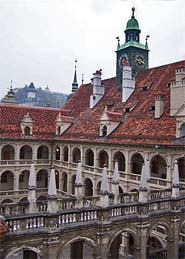 A plaque on the Landhaushof, Herrengasse 16,
reads, "Parliamentary Rules of Behavior- No noise,
No arms, No fighting" (they'd never tolerate
anything like Question Period in Ottawa!). The facade is
impressive but the courtyard is a show-stopper. With
arcades reminscent of a Venetian Palazzo, this stunning
jewel of Italian Renaissance architecture was created by
Domenico dell'Allio. This is the home of the Styrian
provincial parliament and as a group of gentlemen
approached, our friendly greeting yielded an unexpected
reward. We were introduced to none other than the Prime
Minister of Styria, Franz Voves. We chatted and learned
that he had been a professional hockey player and was
happy that the pros were back at it after the lockout.
A plaque on the Landhaushof, Herrengasse 16,
reads, "Parliamentary Rules of Behavior- No noise,
No arms, No fighting" (they'd never tolerate
anything like Question Period in Ottawa!). The facade is
impressive but the courtyard is a show-stopper. With
arcades reminscent of a Venetian Palazzo, this stunning
jewel of Italian Renaissance architecture was created by
Domenico dell'Allio. This is the home of the Styrian
provincial parliament and as a group of gentlemen
approached, our friendly greeting yielded an unexpected
reward. We were introduced to none other than the Prime
Minister of Styria, Franz Voves. We chatted and learned
that he had been a professional hockey player and was
happy that the pros were back at it after the lockout.
[Back
to Top]
The Parish church next door, with its Baroque facade and Gothic interior, has a stained glass window that portrays Hitler and Mussolini as willing observers to a crowd beating Jesus, which symbolizes their inhumanity.
For a sweeter thought, go next door to Ferdinand Haller and smell the chocolate on display and check out the gorgeous Baroque ceiling.
Next to the Landhaus is the Landeszeughaus (armory), entrance on Herrengasse, which has the world's largest historical collection of weaponry with about 32,000 pieces. It is literally a warehouse. Four large floors are stacked high with wooden shelving all filled to the brim and piled all the way to the high ceiling with many pieces hanging from the ceiling over the aisles. Rifles, pistols, body armor, cannons, spears, swords, shields, horse armor etc. are perfectly preserved and maintained. It is a stunning display that is carefully watched over by guards on every floor.
Opposite the Landhaushof is a gorgeous inner courtyard, the Generalifhof, in which jazz concerts are presented in the summer months. We found many of these picturesque courtyards as we roamed about, just keep looking.
The main square, Hauptplatz, was
established in 1160 and redesigned in 2002. With an 1878
statue in memory of the Styrian Prince Archduke Johann,
magnificent houses of Baroque and Gothic origin, narrow
alleyways lined with neat shops bustling with young
people shopping and socializing and street entertainers,
it represents the spirit of Graz. In the 19th century
Graz was known as the city of the retired; today it is
young and vibrant. 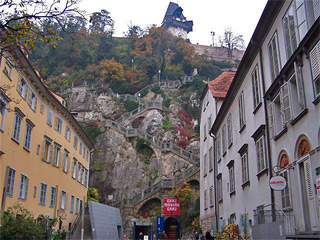
No visit to Graz is
complete without a trip to the rooftop of Graz,
Schlossberg, Castle Hill, with its historical clock tower
looming over the city. You can walk up the steep green
hill (472 meters high) or take the Schlossbergbahn (funicular).
There is a tunnel system at the base of the hill that was
used during WWII for defensive purposes that is now used
as exhibition space. From the castle hill we could see
all that makes Graz so fascinating: the old rooftops and
streets, courtyards and squares around us, the river with
the Murinsel (island on the Mur) bridging the way to the
Kunsthaus Graz, the ultra modern exhibition center.
[Back
to Top]
Murinsel was one of the main
architectural projects of the Cultural Capital year 2003.
The floating island resembles a giant open clam shell,
connected to the shores of the Mur by walkways. In it is
a cafe, an amphitheatre and play area. It's a place for
young and old to take sun and enjoy the flowing river
rushing by. 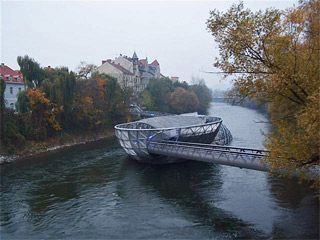
The narrow charming Franziskanergasse leads to Franziskanerplatz, home of the Franziskanerviertal (Franciscan quarter) and the Franziskanerkloster, the only Franciscan Monastery in Austria. The Franciscan quarter is sometimes called the "calf district" because of the numbers of butchers and sausage sellers who have been here for centuries. It's a colorful setting for the sidewalk restaurants and cafes that specialize in Mediterranean offerings. The Franciscan church is the oldest religious order in Graz.
When we returned in the early evening we found that the water did not drain in the shower, which could not be solved, so we were moved to another room which was even larger but was equipped with a Murphy bed with a rock hard mattress. We had planned to go to a cello concert at the Opera House but after a too long nap and the water problem, room switching, etc., we gave up on the idea.
It's interesting to note that the contemporary steel sculpture called Light Sword, in front of the Opera House, which had initially caused controversy, became a symbol of Graz's cosmopolitan attitude.
A fantastic selection of rolls
highlighted the very good breakfast buffet, which was
well-attended by businessmen. Updating the bathrooms and
refurbishing the guest rooms of the hotel would go a long
way toward making the total experience match the
excellent service. 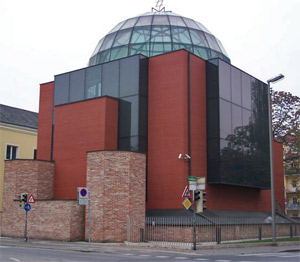
The Graz Synagogue
was just a few blocks from the hotel at David-Herzog-Platz
at the corner of Zeiglgasse and Grieskai. It is an
attractive modern design of red masonry and glass with a
striking large glass dome with biblical inscriptions overhead in the
sanctuary and pillars representing the twelve tribes of
Israel. The congregation consists of one hundred thirty
members. There is no full time rabbi but on the day we
visited, the rabbi was coming from Vienna to officiate at
a bar-mitzvah.
[Back
to Top]
On the way back to the hotel, we spotted the shirtmaker Sir Hemden & Blusen, Grieskai 42, where fine dress and leisure cotton shirts are hand made for men and women and sold directly to the public, including me! I'm enjoying my purchase and feel it was a great bargain considering the quality.
The Kunsthaus Graz, affectionately known to the locals as the Friendly Alien, sits on the banks of the Mur. The innovative biomorphic structure is in stark contrast to the ancient clock tower looming from on high across the river. The old/the new, the past/the future, tradition/avant-garde, while preserving its history, Graz is working hard to greet the future.
This location is further proof of
that intent. Originally the Kunsthaus was to be built
within the Schlossberg mountain walls with the membrane
protruding out of the mountain and into the city like a
dragon's tongue. The concept of the dragon's tongue led
to the present shape of the Friendly Alien. It was
finally decided that building it on this spot, in the
previously disadvantaged area of the city, would serve as
a catalyst for positive change. 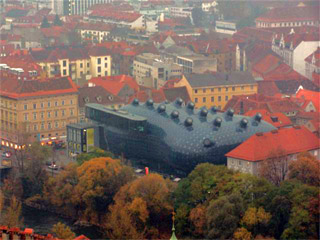
From a distance you cannot miss the strikingly shaped blue "nozzles" that seem to jut out of nowhere. Getting closer we saw that they project out of the body of what appears to be a giant bluish shimmering bubble that floats above a glass walled ground floor. At the corner of SŘdtirolerplatz and Lendkai and linked to the 60 meter wide, 23 meter high Friendly Alien is the "Eisernes Haus", the oldest structure of its kind in Europe. Classified as a historical monument, this cast iron structure was carefully renovated during the construction of the Kunsthaus.
The technical design is far too complex for me to dwell upon. I am satisfied to have seen the array of features and functions in the exhibition areas carefully designed to enhance any presentation or display. The facade is really intriguing with an installation of light rings that aesthetically and functionally integrates architecture, technology and message. The skin of the Kunsthaus is an extraordinary medium for presenting art and related information transfers.
Its mission is to house international exhibitions of multi-disciplinary modern and contemporary art. The Kunsthaus Graz will have neither a collection of its own nor a permanent exhibition nor will there be permanent storage nor research facilities.
The ground floor houses reception, encased models of local interest and a cafe/restaurant. A slow moving ramp known as the "Pin" moves "up into the unknown" (ever-changing) from the glazed foyer to the skin-encased body of the Friendly Alien.
The present exhibition, "M City"- European Landscapes, will be on display until Jan.8,2006. Since the existence of the modern city, the urban aspect of city living has held a fascination for artists and a theme for artistic and theoretical examination. Is the European city a discontinued model? The multiple aspects of urban change form the central theme for this exhibition and is represented in a varied repertoire of artistic forms designed as a process oriented action whose protagonists, artists, architects and city theorists have followed the invitation and specifically created new works of art and installations for this purpose. The subject matter and presentations are complex and challenging and as we proceeded up the "Pin" into the unknown we were intrigued and stimulated.
At the top floor we found that those nozzles are not just an architectural decoration but that they point north and provide natural light. There is a glass-enclosed lounge for taking a break to enjoy the river and city views, have a beverage and digest all that you've experienced.
We had a delightful lunch at the
ground floor restaurant, Gasthaus Kunsthaus. The menu was
comprised of contemporary light offerings. We followed
the advice of our waitress who suggested the chestnut
cream soup and prawns wrapped in crispy dough with mixed
greens dressed with chili and soy sauce. The fresh orange
juice was delicious. 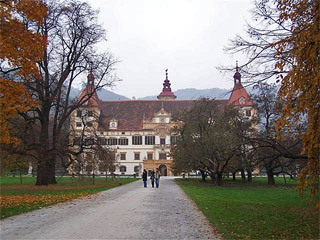
[Back
to Top]
Enjoying the contrast, we boarded the bus in front of the Kunsthaus Graz, Museum of Contemporary Art, to Schloss Eggenberg and the Alte Galerie with 500 years of Austrian and European art history.
It's about a ten-minute walk from the bus stop to the grand walkway leading to the magnificent palace and park. The lovely, sprawling grounds are home to innumerable colorful, friendly peacocks.
The art collection was moved here from the Landhausmuseum Joanneum in September and is beautifully displayed in twenty-two magnificent rooms. Starting at the "Friesach Sacristy Door" from the late 13th century, there are three hundred paintings and sculptures by old masters ranging from the 13th to the18th century plus interesting collections of artifacts, archeological finds and coins.
We were fortunate to have Steven Fowler, an American, as our guide. His knowledge and ability to communicate the essence of what we were seeing made the experience so meaningful for us. When we thanked Steven and expressed our admiration for his knowledge, we were astounded to learn that we were the first people he had ever guided through the gallery. As we write this, we are delighted that Steven, who enjoys traveling, has joined TheTravelzine discussion group.
Krebsen Keller, Sackstrasse 12, telephone 0316-829377 is a popular restaurant tucked into a cute alleyway. After a contemporary lunch in an ultra modern building, why not a traditional dinner in a traditional Styrian restaurant! We relaxed with a glass of that luscious Schilcher wine and switched to dark beer with our meal. Linda had a good beef goulash with white bread dumplings and I, unfortunately, dry tafelspitz with frozen vegetables slathered with cream sauce, unfortunately lots of both to leave behind. The prices were low as was the quality.
Graz is an interesting and captivating city and should be on every Austrian itinerary.
On to Vienna!
[Back
to Top]
Wachau_Krems_Melk_Durnstein
Salzburg | Kufstein_Kitzbuehel
Rattenberg_Hall | Innsbruck
Zell Am See_Kaprun | Spittal
Klagenfurt | Graz | Vienna
Search TheTravelzine | TheTravelzine Group | Don's Gallery
Packing Hints | Planning
Tips | Cities
Links
All pages on TheTravelzine.comęCopyright 1996-2020 Don & Linda Freedman